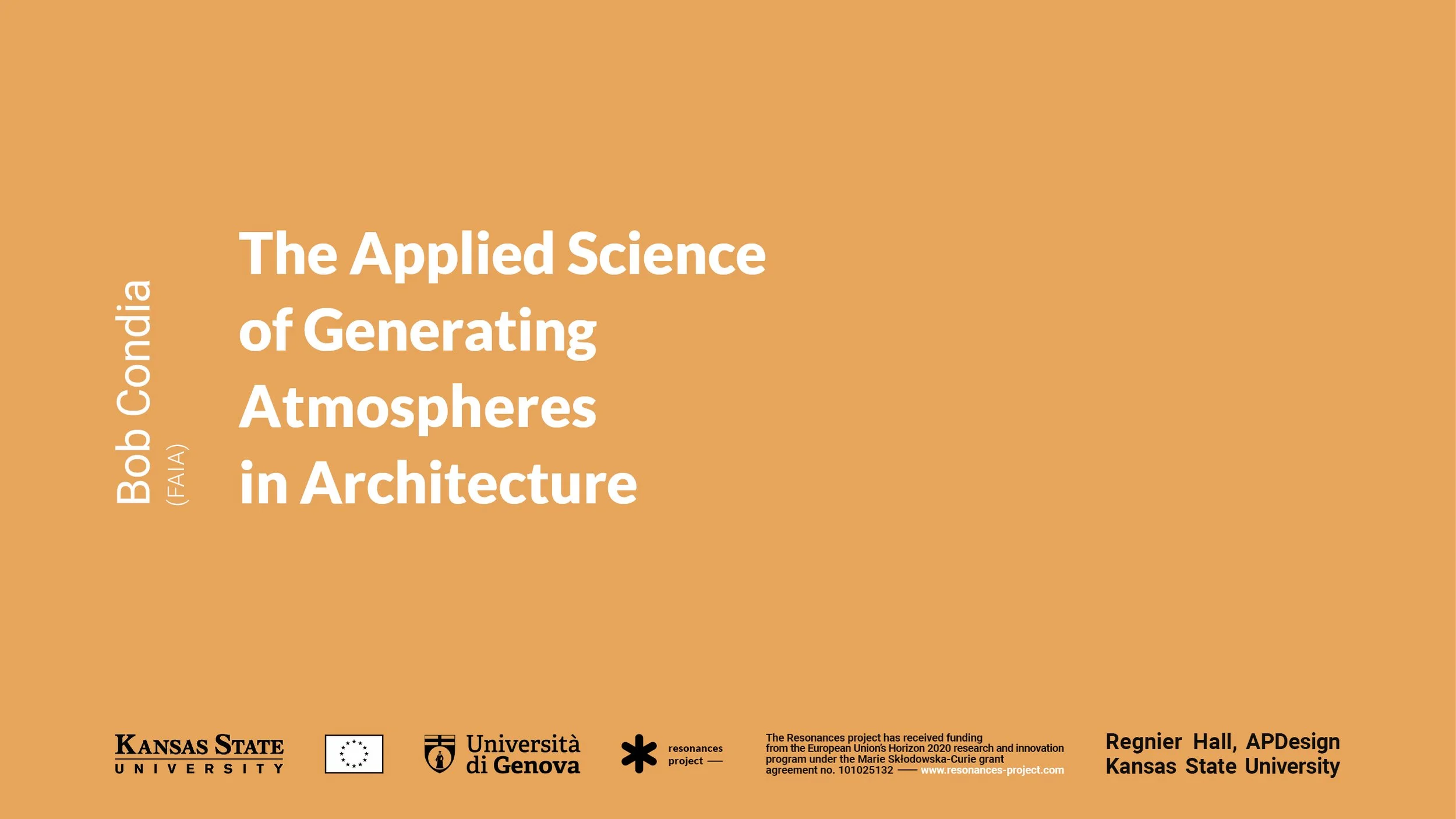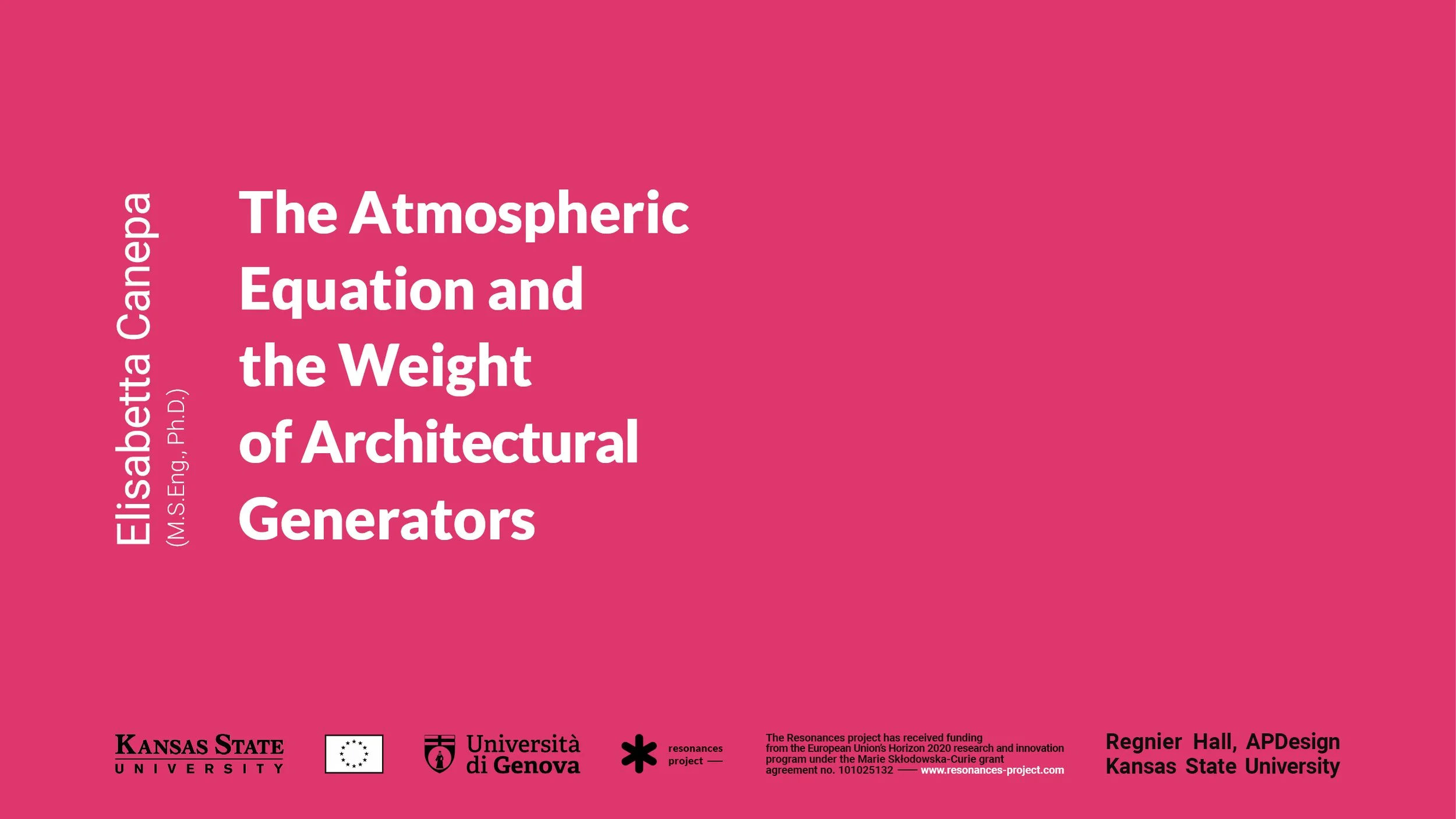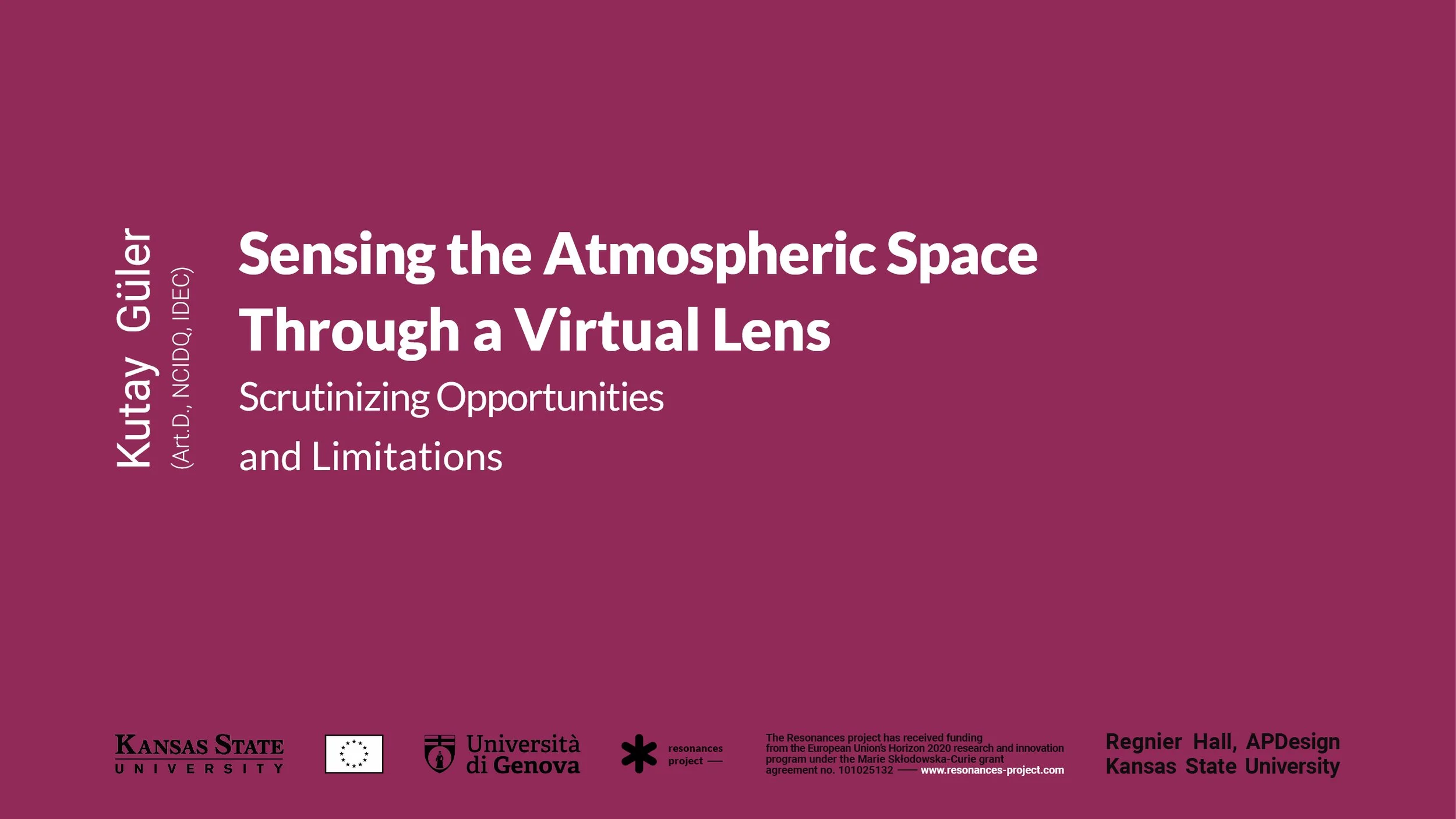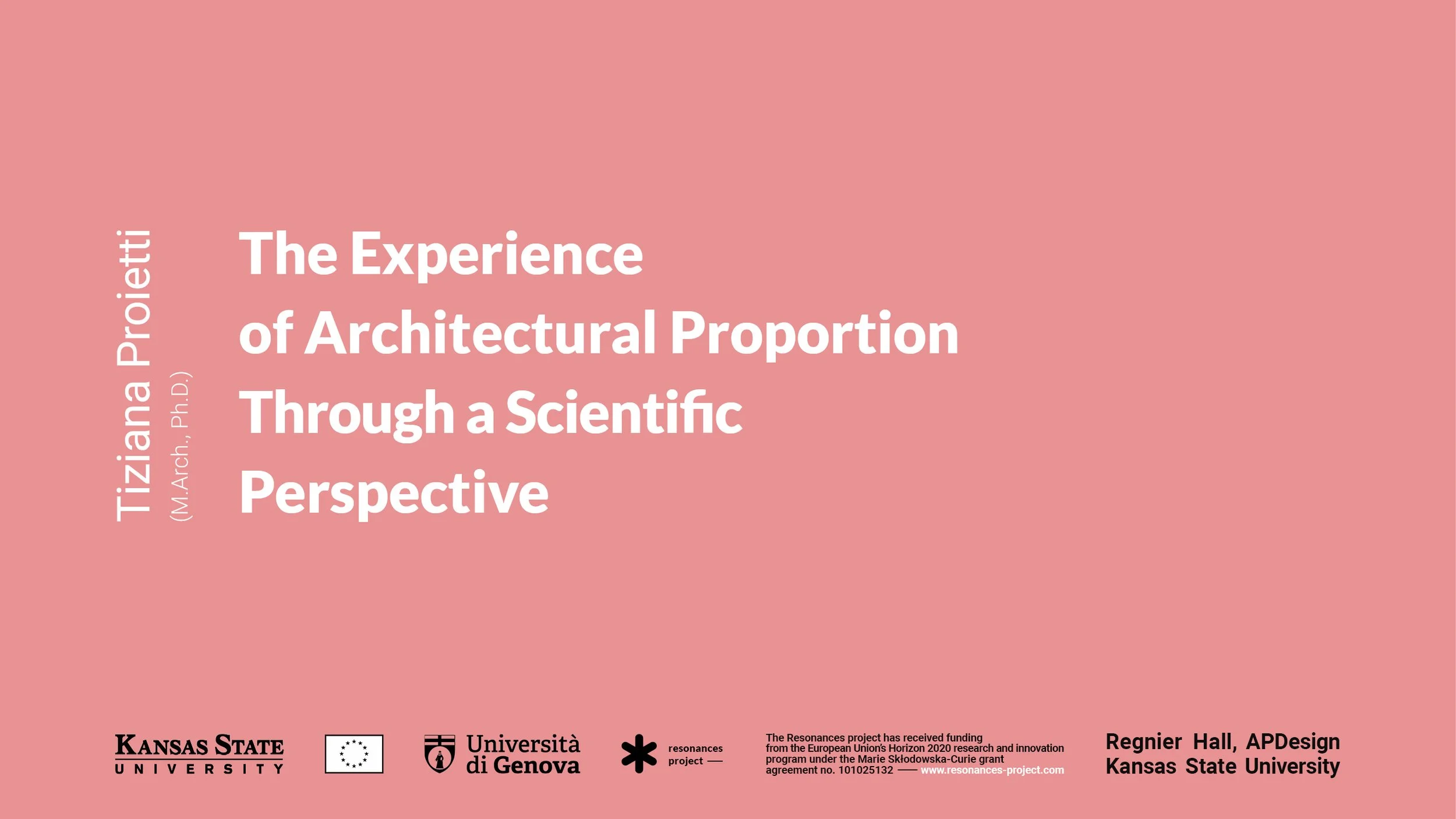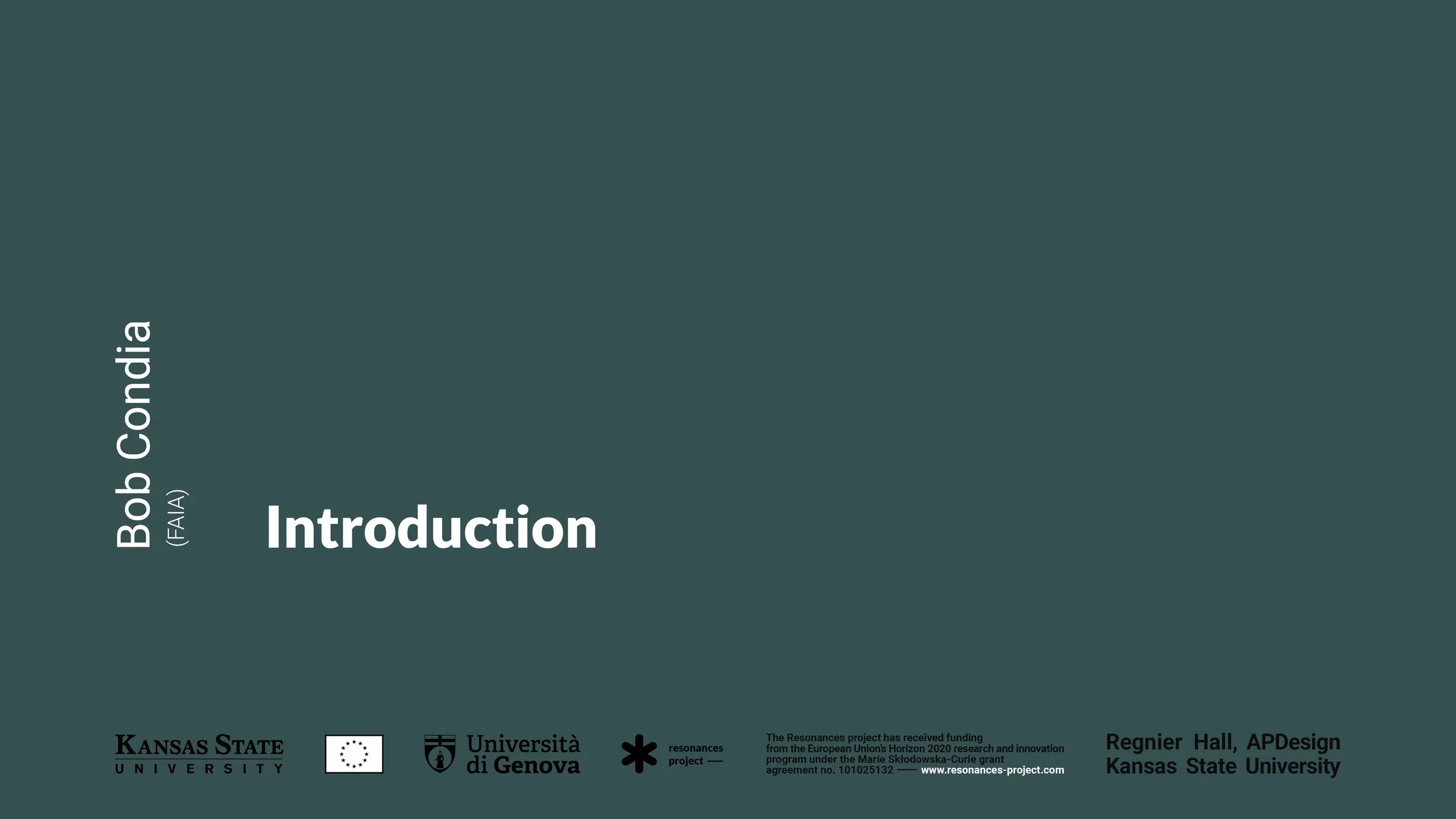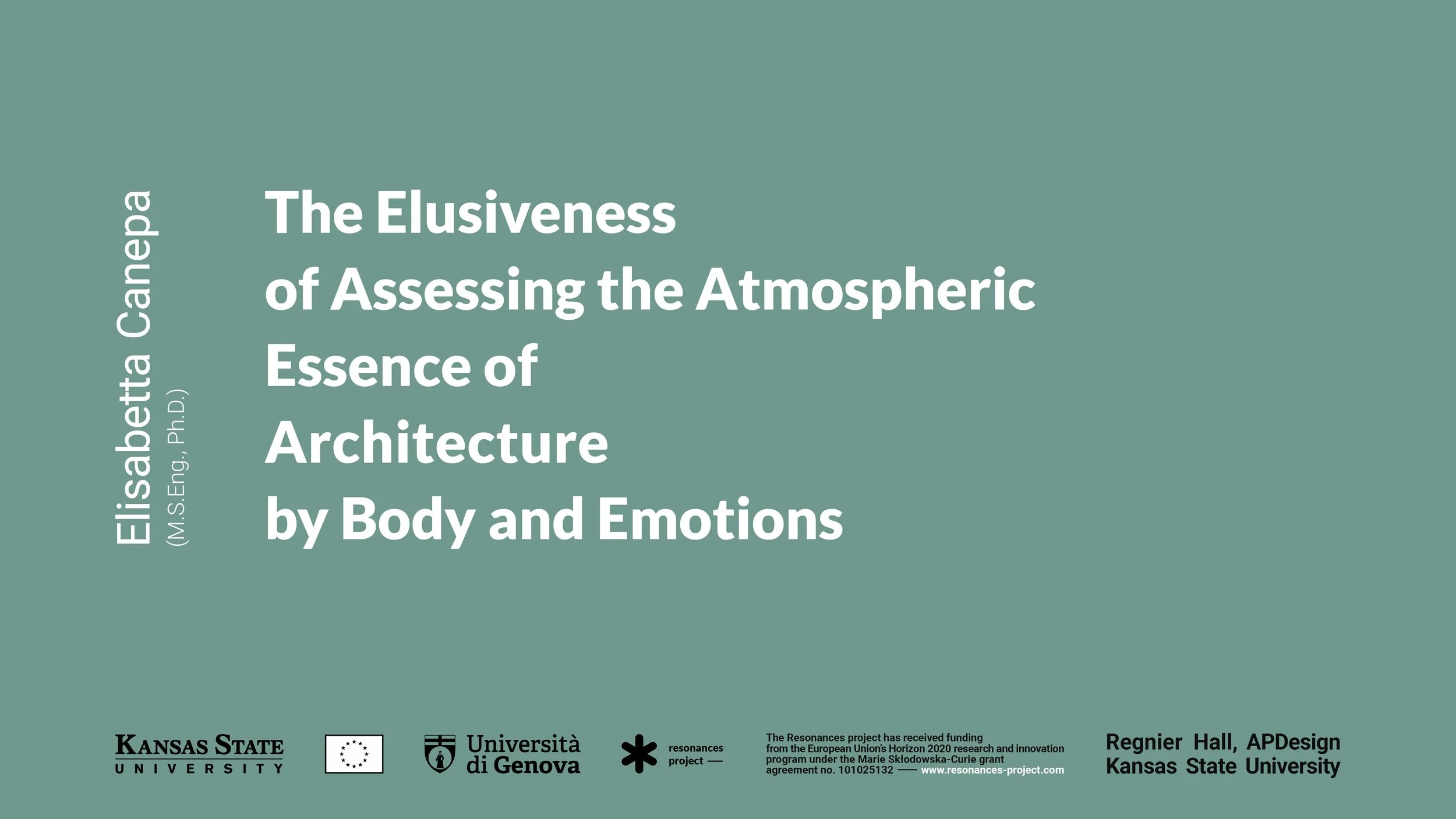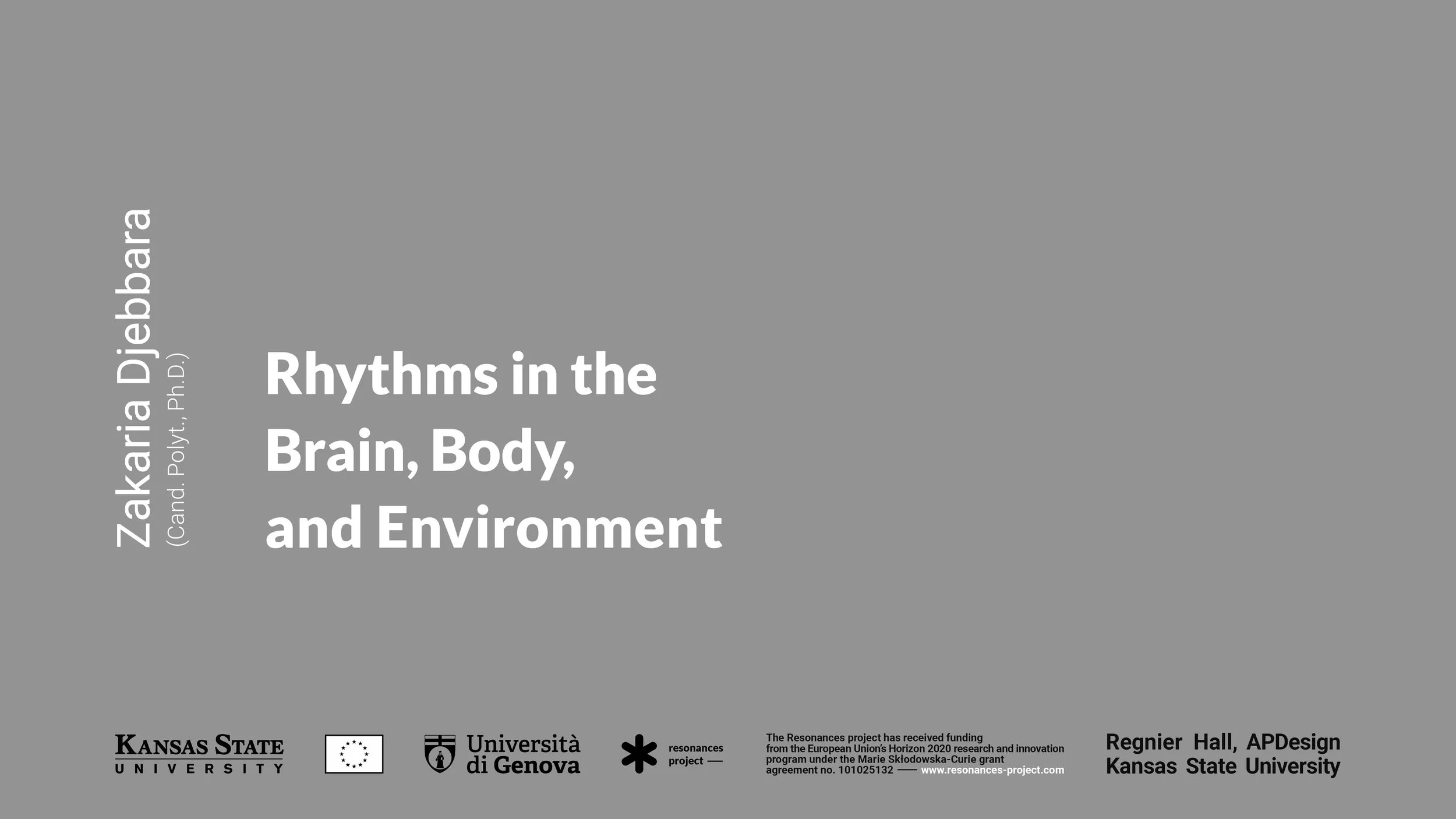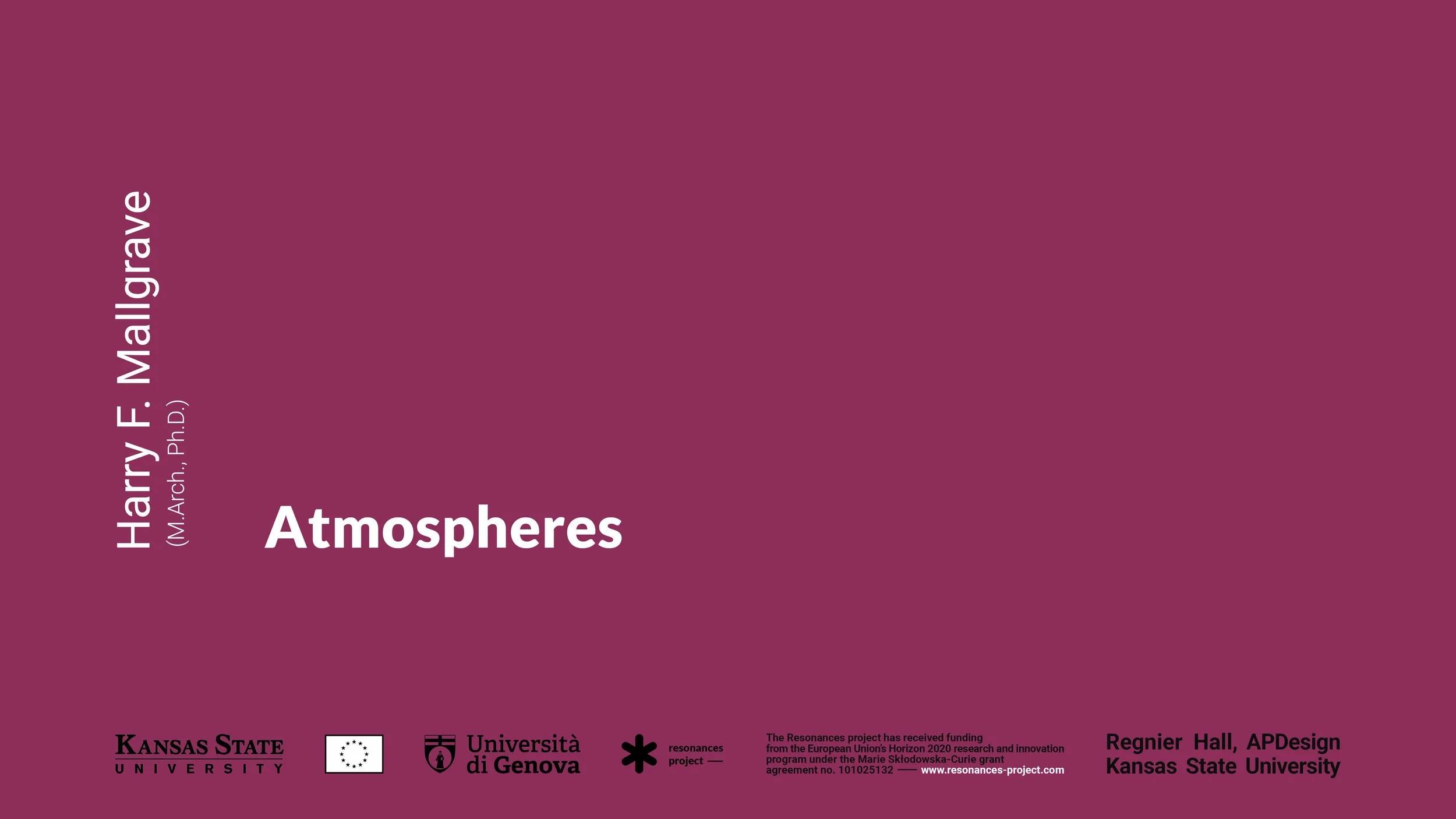Harvest from research
Here you can find all the dissemination
and communication outputs produced by
or related to the RESONANCES project.
Architecture is Atmosphere
Notes on Empathy, Emotions, Body, Brain, and Space
-
Author: Elisabetta Canepa
Foreword: Tenna Doktor Olsen Tvedebrink
ISBN: 9788869773785
Pages: 194
Year: 2022
Publisher: Mimesis International
Place: Milan and Udine
Book series: Atmospheric Spaces
Issue: 11
Director: Tonino Griffero
Translation: Sophie Henderson
Copy editing: Mikaela Wynne
Cover: Francesca Ióvene -
This book explores the atmospheric issue from a connotatively architectural perspective. It is a journey through the maze of atmospheric poetics, articulated in five stages. The first portrays the atmospheric vocation of the architectural experience, unfolding its impalpable essence; the second reconstructs the genealogy, evolution, and semantic geography of the word “atmosphere,” focusing on the architectural niche; the third maps a taxonomy of definitions and design approaches on atmosphere forged over time by the architectural culture; the fourth discusses the current atmospheric turn that inflames architecture; and the fifth provides a new architectural theory of atmosphere of an experiential nature, informed by phenomenological, embodied cognition, and (neuro)biological principles. Atmosphere becomes the key to our empathic relationship with the physical world, capable of orchestrating a space-time continuum of emotions, body, brain, mind, and architecture.
-
This book is a development of the fellow’s doctoral research. The thesis ‘Neurocosmos: The Atmospheric Dimension between Architecture and Neuroscience’ was defended in May 2019 at the Department of Architecture and Design (dAD) of the Polytechnic School of Genoa, under the supervision of Valter Scelsi (architect and professor of architectural and urban design at dAD) and Anna Fassio (professor of human physiology and neurophysiology at DIMES — Department of Experimental Medicine). To conduct the final experiment, Elisabetta also sought the collaboration of Laura Avanzino, neurologist and professor of neurophysiology, and Giovanna Lagravinese, psychologist and researcher — both belonging to DIMES.
Even if this volume is not a direct result of the MSCA fellowship, it touches upon closely related topics and can be considered a positive dissemination result. -
Interfaces 3
Generators of Architectural Atmosphere
-
Editors: Elisabetta Canepa, Bob Condia
Authors: Elisabetta Canepa, Kutay Güler, Tiziana Proietti and Sergei Gepshtein
Introduction: Bob Condia
ISBN: 978-0-9915482-6-2
DOI: 10.5281/zenodo.7191265
Pages: 132
Year: 2022
Publisher: New Prairie Press (NPP)
Place: Manhattan, Kansas, USA
Book series: Interfaces
Issue: 3
Director: Bob Condia
Peer review: scientific board
Copy editing: Kory Beighle, Brittany Coudriet
Graphic design: Elisabetta Canepa, Brittany Coudriet
Cover: Paolo Monti, photo series Udine, 1970 -
This book was born as the legacy of the “Generators of Architectural Atmosphere” Symposium, an Interfaces event of the Academy of Neuroscience for Architecture (ANFA), sponsored by the EU’s Horizon 2020 MSCA Program — RESONANCES Project, the Perkins Eastman Studio, and the 2020 Regnier Chair. The event was hosted in the College of Architecture, Planning and Design (APDesign), Kansas State University, Manhattan, KS, on April 12, 2022.
Interfaces 3 collects three essays: “The Atmospheric Equation and the Weight of Architectural Generators” by Elisabetta Canepa; “Sensing the Atmospheric Space Through a Virtual Lens: Scrutinizing Opportunities and Limitations” by Kutay Güler; and “Locating Architectural Atmosphere” by Tiziana Proietti and Sergei Gepshtein. Bob Condia provided a critical introduction entitled “The Applied Science of Generating Atmospheres in Architecture.” -
The “Generators of Architectural Atmosphere” Symposium was sponsored by the EU’s Horizon 2020 MSCA Program — RESONANCES Project, the Perkins Eastman Studio, and the 2020 Regnier Chair.
The RESONANCES project received funding from the European Union’s Horizon 2020 research and innovation program under the Marie Skłodowska-Curie grant agreement no. 101025132. The content of this book reflects only the authors’ view. The European Research Executive Agency is not responsible for any use that may be made of the information it contains.
Generators of Architectural Atmosphere
Symposium
-
With Bob Condia, Elisabetta Canepa, Kutay Güler, Tiziana Proietti
Supported by P\Lab2003
April 12, 2022, 8:30—12:30
Regnier Hall, APDesign, Kansas State University, Manhattan, KS
DOI: 10.5281/zenodo.7051913
-
8:00
Coffee and donuts8:30 Bob Condia
(APDesign — KState, Advisor of ANFA Council, and ACE Member)
Opening remarks, introduction, and sponsorship accolades8:40 Elisabetta Canepa
(MSCA Fellow — UniGe | KState, ANFA and ACE Member)
The Atmospheric Equation and the Weight of Architectural Generators9:30 Kutay Güler
(APDesign, IAID — KState)
Sensing the Atmospheric Space Through a Virtual Lens: Scrutinizing Opportunities and Limitations10:20
Coffee10:50 Tiziana Proietti
(College of Architecture — OU, ANFA and ACE Member)
The Experience of Architectural Proportion Through a Scientific Perspective11:40 Round table
The Applied Science of Generating Atmospheres in Architecture
Bob Condia solicits audience questions for the panel discussion with Elisabetta Canepa, Kutay Güler, and Tiziana Proietti12:30
Finishing up and final remarks -
'Generators of Architectural Atmosphere' Symposium is an Interfaces event of the Academy of Neuroscience for Architecture (ANFA), sponsored by the European Union’s Horizon 2020 MSCA Program — RESONANCES Project, the Perkins Eastman Studio, and the 2020 Regnier Chair.
The RESONANCES project has received funding from the European Union's Horizon 2020 research and innovation program under the Marie Skłodowska-Curie grant agreement no. 101025132.
The content of the produced and published material reflects only the authors’ views. The Research Executive Agency and the European Commission are not responsible for any use that may be made of the information it contains.
The Atmospheric Equation
And the Weight of Architectural Generators
-
Author: Elisabetta Canepa
ISBN: 978-0-9915482-6-2
DOI: 10.5281/zenodo.7530555
Pages: 18–55
Year: 2022
Publisher: New Prairie Press (NPP)
Place: Manhattan, Kansas, USA
Book: Generators of Architectural Atmosphere
Book series: Interfaces
Issue: 3
Director: Bob Condia
Copy editing: Brittany Coudriet
Images: Elisabetta Canepa, Bob Condia, Paolo Monti
Cover: Elisabetta Canepa -
Atmosphere is the whole of affective meanings identifying a situation or place that allows us to resonate and tune into our surroundings. The complexity of atmosphere is well known. This essay analyzes the — design and aleatory — determinants that prime atmospheric effects to estimate the contribution provided by the physical environment (namely, the architect’s domain of intervention). Staging atmospheres is a compositional task in which we orchestrate different architectural generators to let our bodies emotionally resonate with the multisensory entirety of forms, materials, shades, colors, sounds, and scents that constitute a place. Designed atmospheres become generators of identity and meaning.
Keywords
architectural composition
meaning
identity
atmosphere
emotions
body
resonance
attunement
aleatory determinants
design determinants
generators of atmosphere -
The theoretical premises of this essay were developed within the RESONANCES project.
The RESONANCES project has received funding from the European Union's Horizon 2020 research and innovation program under the Marie Skłodowska-Curie grant agreement no. 101025132.
The content of this text reflects only the author’s view. The European Research Executive Agency is not responsible for any use that may be made of the information it contains.
Interfaces 4
Designing Atmospheres: Theory and Science
-
Editors: Elisabetta Canepa, Bob Condia
Authors: Kory Beighle, Elisabetta Canepa, Zakaria Djebbara, and Harry Francis Mallgrave
Introduction: Bob Condia
ISBN: 978-1-944548-49-0
DOI: 10.5281/zenodo.7951750
Pages: 176
Year: 2023
Publisher: New Prairie Press (NPP)
Place: Manhattan, Kansas, USA
Book series: Interfaces
Issue: 4
Director: Bob Condia
Peer review: scientific board
Copy editing: Gabrielle Coleman, Brittany Coudriet
Graphic design: Elisabetta Canepa
Cover: Paolo Monti, photo series Venezia, 1950 -
This book was born as the legacy of the “Designing Atmospheres: Theory and Science” Symposium, an Interfaces event of the Academy of Neuroscience for Architecture (ANFA), sponsored by the EU’s Horizon 2020 MSCA Program — RESONANCES Project, the Perkins Eastman Studio, and the Architecture Department at Kansas State University. The event was hosted in the College of Architecture, Planning and Design (APDesign), Kansas State University (K-State), Manhattan, KS, on March 28, 2023.
Interfaces 4 collects four essays: “Investigating Atmosphere in Architecture: An Overview of Phenomenological and Neuroscientific Methods” by Elisabetta Canepa; “Rhythms of the Brain, Body, and Environment: A Neuroscientific Perspective on Atmospheres” by Zakaria Djebbara; “A History of Tool-Atmospheres” by Kory Beighle; and “Atmospheric Histrionics” by Harry Francis Mallgrave. Bob Condia provided a critical introduction entitled “The Design of Atmospheres.” -
The “Designing Atmospheres: Theory and Science” Symposium was sponsored by the EU’s Horizon 2020 MSCA Program — RESONANCES Project, the Perkins Eastman Studio, and the Architecture Department at Kansas State University (K-State).
The RESONANCES project received funding from the European Union’s Horizon 2020 research and innovation program under the Marie Skłodowska-Curie grant agreement no. 101025132. The content of this book reflects only the authors’ view. The European Research Executive Agency is not responsible for any use that may be made of the information it contains.
Designing Atmospheres:
Theory and Science
Symposium
-
With Kory Beighle, Elisabetta Canepa, Bob Condia, Zakaria Djebbara, Harry Francis Mallgrave
Supported by P\Lab2003
March 28, 2023, 8:30—12:30
Regnier Hall, APDesign, Kansas State University, Manhattan, KS
DOI: 10.5281/zenodo.7930280
-
8:00
Coffee and donuts8:30 Bob Condia
(APDesign — KState, Member of the ANFA Advisory Council)
Opening remarks, introduction, and sponsorship accolades8:40 Elisabetta Canepa
(MSCA Fellow — UniGe | KState, Member of the ANFA Advisory Council)
The Elusiveness of Assessing the Atmospheric Essence of Architecture by Body and Emotions9:30 Zakaria Djebbara
(CREATE — AAU, BPN — TU Berlin)
Rhythms in the Brain, Body, and Environment10:20
Coffee10:50 Kory Beighle
(APDesign — KState)
A History of Tool-Atmospheres11:40 Harry Francis Mallgrave
(Distinguished Professor Emeritus — IIT, Member of the ANFA Advisory Council)
Atmospheres12:30
Finishing up and final remarks -
'Designing Atmospheres: Theory and Science' Symposium is an Interfaces event of the Academy of Neuroscience for Architecture (ANFA), sponsored by the EU’s Horizon 2020 MSCA Program — RESONANCES Project, the Perkins Eastman Studio, and the Department of Architecture at Kansas State University (K-State).
The RESONANCES project received funding from the European Union's Horizon 2020 research and innovation program under the Marie Skłodowska-Curie grant agreement no. 101025132.
The content of the produced and published material reflects only the authors’ views. The Research Executive Agency and the European Commission are not responsible for any use that may be made of the information it contains.
Investigating Atmosphere in Architecture
An Overview of Phenomenological and Neuroscientific Methods
-
Author: Elisabetta Canepa
ISBN: 978-1-944548-49-0
DOI: 10.5281/zenodo.8045570
Pages: 27–71
Year: 2023
Publisher: New Prairie Press (NPP)
Place: Manhattan, Kansas, USA
Book: Designing Atmospheres. Theory and Science
Book series: Interfaces
Issue: 4
Director: Bob Condia
Copy editing: Brittany Coudriet
Images: Elisabetta Canepa, Paolo Monti
Cover: Paolo Monti, photo series Bitonto, 1970, BEIC 6332714 -
Based on the multi-component character of our emotions, we can study the affective dimension of architectural atmospheres through several approaches. This essay reviews the main research models that employ a first-person perspective (self-observation) and a third-person perspective (external observation), analyzing methodological potentials and limitations. We need a multi-perspective approach to investigate the complexity of the atmospheric vocation of architecture, integrating both models and working on complementary notions: atmosphere and architecture, resonance and attunement, impressions and appraisals, nonconscious and conscious, emotions and feelings, living body and lived body, neuroscience and phenomenology, physiological measures and self-report techniques.
Keywords
architecture
atmosphere
attunement
resonance
feeling
emotion
lived body
living body
conscious
nonconscious
first-person perspective
third-person perspective
phenomenology
neuroscience -
This essay was developed within the RESONANCES project, which received funding from the European Union's Horizon 2020 research and innovation program under the Marie Skłodowska-Curie grant agreement no. 101025132.
The content of this text reflects only the author’s view. The European Research Executive Agency is not responsible for any use that may be made of the information it contains.
Interfaces 5
Atmosphere(s) for Architects:
Between Phenomenology and Cognition
-
A dialogue between Michael Arbib and Tonino Griffero
Editors: Elisabetta Canepa, Bob Condia, Mikaela Wynne
Authors: Michael Arbib, Elisabetta Canepa, Bob Condia, Federico De Matteis, Tonino Griffero, Robert Lamb Hart, Mark Alan Hewitt, Suchi Reddy, Mikaela Wynne
ISBN: 978-1-944548-50-6
DOI: 10.5281/zenodo.8111656
Pages: 358
Year: 2023
Publisher: New Prairie Press (NPP)
Place: Manhattan, Kansas, USA
Book series: Interfaces
Issue: 5
Director: Bob Condia
Peer review: scientific board
Copy editing: Kory A. Beighle, Gabrielle Coleman, Brittany Coudriet
Graphic design: Elisabetta Canepa, Amanda Shearhart
Cover: Markus Krisetya, Salk Institute for Biological Studies, 2017 -
Interfaces 5 was born to home the dialogue that the neuroscientist Michael A. Arbib and the philosopher Tonino Griffero started at the end of 2021 about atmospheric experiences, striving to bridge the gap between cognitive science’s perspective and the (neo)phenomenological one. This conversation progressed due to Pato Paez’s offer to participate in the webinar “Architectural Atmospheres: Phenomenology, Cognition, and Feeling,” a roundtable hosted by The Commission Project (TCP) within the Applied Neuroaesthetics initiative. The event ran online on May 20, 2022. Bob Condia moderated the panel discussion between Suchi Reddy, Michael A. Arbib, and Tonino Griffero.
This volume collects nine essays: the main chapter is “A Dialogue on Affordances, Atmospheres, and Architecture” by Michael A. Arbib and Tonino Griffero; there are four commentaries to this text by Federico De Matteis, Robert Lamb Hart, Mark Alan Hewitt, and Suchi Reddy; Michael A. Arbib and Tonino Griffero have independently responded to the commentaries, emphasizing the opportunities and challenges of their respective approaches: cog/neuroscience and atmospherology applied to architecture; Elisabetta Canepa offers “An Essential Vocabulary of Atmospheric Architecture,” developing an atmospherological critique of the Marianna Kistler Beach Museum of Art on the Kansas State University campus to evaluate the accuracy, coherence, and adaptability of her lexicon. Bob Condia and Mikaela Wynne provide an introduction entitled “On Becoming an Atmospherologist: A Praxis of Atmospheres.” -
The RESONANCES project was responsible for editing and publishing Interfaces 5.
This project received funding from the European Union’s Horizon 2020 research and innovation program under the Marie Skłodowska-Curie grant agreement no. 101025132. The content of this book reflects only the authors’ view. The European Research Executive Agency is not responsible for any use that may be made of the information it contains.
An Essential Vocabulary of Atmospheric Architecture
Experiencing, Understanding, and Narrating Kansas State’s Beach Museum of Art
-
Author: Elisabetta Canepa
ISBN: 978-1-944548-50-6
DOI: 10.5281/zenodo.8161944
Pages: 276–349
Year: 2023
Publisher: New Prairie Press (NPP)
Place: Manhattan, Kansas, USA
Book: Atmosphere(s) for Architects: Between Phenomenology and Cognition
Book series: Interfaces
Issue: 5
Director: Bob Condia
Copy editing: Brittany Coudriet
Cover: Elisabetta Canepa, 2023 -
Informed by (new) phenomenology and cog/neuroscience and grounded in the architectural discipline’s expertise, atmospherology (namely, the study of affective atmospheres in space) can benefit from a shared lexicon to encourage mutual understanding and knowledge construction. A basic language of atmosphere helps cultivate an affective education that makes architects capable of articulating tacit experiences and designing atmospheric qualities. Fifteen essentials are discussed: affordance, arousal, atmosphere, attunement, body, conscious, emotion, feeling, first impression, generator of atmosphere, lived space, mood, nonconscious, resonance, and valence. Lastly, this essay develops an atmospherological critique of the Marianna Kistler Beach Museum of Art on the Kansas State University campus in Manhattan (Kansas) to evaluate the accuracy, coherence, and adaptability of the lexicon’s concepts.
Keywords
architecture
phenomenology
neuroscience
atmosphere
atmospherology
affective education
tacit experience
language of atmosphere
Kansas State’s Beach Museum of Art -
This essay was developed within the Resonances project — Architectural Atmospheres: The Emotional Impact of Ambiances Measured through Conscious, Bodily, and Neural Responses. This project received funding from the European Union’s Horizon 2020 research and innovation program under the Marie Skłodowska-Curie grant agreement no. 101025132. The content of this text reflects only the author’s view. The European Research Executive Agency is not responsible for any use that may be made of the information it contains.
Writing the section about the Beach Museum was possible thanks to the support of many professionals and institutions: Linda Duke (former director), Sarah Price (registrar and collection manager), Kathrine Schlageck (associate curator of education), Lindsay Smith (exhibition designer), and Marvin Gould (exhibition designer) from K-State Beach Museum of Art; Bob Condia (architecture professor) and Katie Kingery-Page (associate dean) from the K-State College of Architecture, Planning and Design; K-State Division of Facilities; K-State Division of Communications and Marketing; K-State Department of Special Collections; and Andersson/Wise Architects. I am grateful to Michael Arbib for his support in improving my draft.
Emilio Ambasz, Residence-au-Lac
Atmosfere, emozioni e realtà virtuale
-
Author: Elisabetta Canepa
DOI: 10.5281/zenodo.10828094
Paper: Emilio Ambasz, Residence-au-Lac. Atmosfere, emozioni e realtà virtuale
Book: IDEA — Innovation Design Application (2024 edition). Conference Proceedings
Editor: Gaia Leandri
e-ISBN: 978-88-3618-261-9 (pdf)
Pages: 200–221
Year: 2024
Publisher: Genoa University Press (GUP)
Place: Genoa, Italy
GUP website: www.gup.unige.it
Series: Full Papers, 3
Language: Italian -
Architectural research has recently started to interact with neuroscientific knowledge by integrating their theories and through experiment-based investigations to study how we perceive, feel, and interpret the world we inhabit. Architects play a crucial role in this interdisciplinary challenge: they design the experimental stimuli to spatially situate the task to be performed and elicit a response (conscious or nonconscious). Capable of confining physical space into a whole and independent form and limiting the number of affecting variables, rooms are the privileged testing ground. This paper analyzes the room employed in a virtual reality experiment exploring atmospheric perception. There are three key points: [1] we discuss the architectural precedent (the renovation project of the Residence-au-Lac lobby developed by Emilio Ambasz in the early Eighties on the shore of Lake Lugano); [2] scoring real-time questions and memory-informed assessments, we examine the emotional experience lived in a virtual environment that reinterprets this project; and [3] we compare the participants’ appraisals to the architect’s intentions and critics’ reviews to see if atmospheric impressions resonate with design expectations. Spoiler: the virtual simulation inspired by Ambasz’s room was effective at irradiating an oneiric atmosphere and evoking pleasant, serene, and uplifting feelings — as imagined by its creator, praised by critics, and hypothesized by the experimenters.
Keywords
Emilio Ambasz
Residence-au-Lac
atmospheric perception
feelings
virtual reality -
This paper was developed within the RESONANCES project — Architectural Atmospheres: The Emotional Impact of Ambiances Measured through Conscious, Bodily, and Neural Responses.
The RESONANCES project received funding from the European Union’s Horizon 2020 research and innovation program under the Marie Skłodowska-Curie grant agreement no. 101025132. The content of this text reflects only the author’s view. The European Research Executive Agency is not responsible for any use that may be made of the information it contains.
The author thanks Emilio Ambasz for sharing the project’s images from his archive.
Motion and Emotion
Understanding Urban Architecture through Diverse Multisensorial Engagements
-
Authors: Tenna D.O. Tvedebrink, Lars B. Fich, Elisabetta Canepa, Zakaria Djebbara, Asbjørn C. Carstens, Dylan Chau Huynh, and Ole B. Jensen
Journal: The Journal of Somaesthetics 8 (2, special issue entitled ‘Body, Space, Architecture’)
ISSN: 2246-8498
Pages: 9–29
Year: 2022
Publisher: Aalborg University Press
Place: Aalbork, Denmark
Journal website: somaesthetics.aau.dk
The Journal of Somaesthetics was founded by Richard Shusterman, Else Marie Bukdahl, and Ståle Stenslie. It is funded by The Joint Committee for Nordic research councils in the Humanities and Social Sciences, NOS-HS, and Independent Research Fund Denmark
Copy editing: Brittany Coudriet
Images: Lars B. Fich and Tenna D.O. Tvedebrink
Cover: Elisabetta Canepa -
Understanding how (dis)abled human bodies interact with the built environment is critical in Urban Design. We examine if somaesthetic theory combined with a neuro-architectural framework can help advance our understanding of human bodily interaction with the built environment. We do so first from a theoretical point of view, and second with an analysis of the situated context: Budolfi Square in Aalborg, Denmark. Our take-home-message is that architects and urban designers need to move beyond the established understanding of the multi-sensory soma, into an understanding of a situated mobile-emotional soma.
Keywords
somaesthetics
neuroarchitecture
human body spectrum
situated relational interaction
mobile-emotional soma -
Even if this paper is not a direct result of the MSCA fellowship, it touches upon closely related topics and can be considered a positive dissemination result.
This paper was written in collaboration with the Situated Mobilities and Sensing Bodies (SitMoB) group. SitMob is hosted at the Department of Architecture, Design, and Media Technology (CREATE) and the Centre for Mobilities and Urban Studies (C-MUS) at Aalborg University, Denmark. The CREATE Department is the European partner of the RESONANCES project: Elisabetta Canepa, the MSCA fellow, spent her initial outcoming period here.
GUD 7 2023
Special issue: SYNAPSE
-
Journal: GUD (Genoa University Design): A Magazine about Architecture, Design and Cities 7 (special issue entitled ‘Sinapsi / Synapse’)
Guest editors: Elisabetta Canepa, Andrea Giachetta, and Gaia Leandri
ISSN: 1720-075X
Pages: 1–176
Year: 2023
Publisher: Stefano Termanini Editore
Place: Genoa, Italy
Journal website: www.stefanotermaninieditore.it
GUD is an open-access journal, rated as a “scientific journal” by the Italian National Agency for the Evaluation of the University and Research Systems (ANVUR)
Cover: Perry Kulper, 2018 -
GUD (Genoa University Design): A Magazine about Architecture, Design, and Cities 7, special issue on Synapse, edited by Elisabetta Canepa, Andrea Giachetta, and Gaia Leandri
Contributions by Andrea Giachetta, Gaia Leandri, Dario Costi, Paolo Presti, Pietro Avanzini, Fausto Caruana, Giacomo Rizzolatti, Giovanni Vecchiato, Matteo Zambelli, Michele Valentino, Fabio Bacchini, Linda Buondonno, Germana Pareti, Marta Stragà, Manila Vannucci, Fabio Del Missier, Sergio Agnoli, Matteo Pericoli, Cinzia Di Dio, Davide Ruzzon, Sara Valentina Schieppati, Giulia Peretti, Federica Sanchez, Davide Massaro, Gabriella Gilli, Antonella Marchetti, Fabio Colonnese, Anna Anzani, Massimo Schinco, Veronica Riavis, Antonio Sorrentino, Eleonora Buiatti, Mahtab Mazlouman, Lorella Pizzonia, Roberto Ruggiero, Claudia Porfirione, Isabella Nevoso, Elena Polleri, Valeria Menchetelli, and Elisabetta Canepa
Keywords
architecture
neuroscience
synapse -
Elisabetta Canepa’s contribution was developed within the RESONANCES project — Architectural Atmospheres: The Emotional Impact of Ambiances Measured through Conscious, Bodily, and Neural Responses. This project received funding from the European Union's Horizon 2020 research and innovation program under the Marie Skłodowska-Curie grant agreement no. 101025132. The content of this text reflects only the author's view. The European Research Executive Agency is not responsible for any use that may be made of the information it contains.
Orizzonti di ricerca tra architettura e neuroscienze
A vent’anni dalla nascita di ANFA — The Academy of Neuroscience for Architecture
-
Author: Elisabetta Canepa
Journal: GUD (Genoa University Design): A Magazine about Architecture, Design and Cities 7 (special issue entitled ‘Sinapsi / Synapse’)
DOI: 10.5281/zenodo.8161254
ISSN: 1720-075X
Pages: 168–175
Year: 2023
Publisher: Stefano Termanini Editore
Place: Genoa, Italy
Journal website: www.stefanotermaninieditore.it
GUD is an open-access journal, rated as a “scientific journal” by the Italian National Agency for the Evaluation of the University and Research Systems (ANVUR)
Text editor: Luigi Mandraccio
Cover: Perry Kulper, 2018 -
GUD (Genoa University Design): A Magazine about Architecture, Design, and Cities 7, special issue on Synapse, edited by Elisabetta Canepa, Andrea Giachetta, and Gaia Leandri.
As a GUD 7 editor, Elisabetta Canepa offers a critical overview of the twenty published papers (written by scholars of interiors, architecture, and city design in collaboration with cognitive scientists and philosophers), situating the contributions in a more complete and complex context of reference. The ANFA 20th Anniversary Conference (September 2023) provides a fruitful prompt to analyze potentials, challenges, and horizons of the convergence of architecture (the art of building) and neuroscience (the experimental study of experience), now invoked with enthusiasm as demonstrated by the progressive and constant increase of publications, symposiums, exhibitions, workshops, and academic curricula dedicated to this interdisciplinary field.
Keywords
architecture
neuroscience
synapse
ANFA (the Academy of Neuroscience for Architecture) -
This essay was developed within the RESONANCES project — Architectural Atmospheres: The Emotional Impact of Ambiances Measured through Conscious, Bodily, and Neural Responses. This project received funding from the European Union's Horizon 2020 research and innovation program under the Marie Skłodowska-Curie grant agreement no. 101025132. The content of this text reflects only the author's view. The European Research Executive Agency is not responsible for any use that may be made of the information it contains.
Resonant Architecture
The Situated Poetics of Antonio Jiménez Torrecillas
-
Author: Elisabetta Canepa
Journal: Oz 44 (special issue entitled ‘Essence of Discipline’)
DOI: 10.5281/zenodo.7023675
ISSN: 0888-7802
Pages: 4–11
Year: 2022
Publisher: New Prairie Press (NPP)
Place: Manhattan, Kansas, USA
Oz is a nonprofit journal edited, designed, and produced annually by students in the Kansas State University College of Architecture, Planning and Design (APDesign)
Copy editing: Sophie Henderson
Images: Antonio Luis Martínez Cano; Fanny-Laure Bovet
Cover: Antonio Luis Martínez Cano -
There are architectures that, more than others, seem to exist for their nature of atmospheric, resonant bodies: they are shells that enclose, protect, and reverberate the internal landscape of our sensibility. These architectures, in being diaphragms designed to regulate external factors, such as daylight, breeze, and temperature, function above all as a source of emotional priming and contagion. They sway our first impressions (bodily resonance) and modulate our affective involvement (attunement). Two projects by the Andalusian architect Antonio Jiménez Torrecillas describe his extraordinary ability to shape the atmospheric vocation of architectural experience, staging affectively situated events. The journey inside the Nasrid Wall in Upper Albaicín, the Moorish quarter of the city of Granada, (2002-2008) and the seaside house in Rota designed for a famous couple of writers, Luis García Montero and Almudena Grandes, (2012-2015) is an homage to Antonio, master of atmospheres.
Oz 44, Essence of Discipline
Edited by Haneen Abu-Sherbi and Matthew Cox
Increasingly the discipline of architecture assumes the demands posed by a rapidly changing society, responding to issues in an evolving world. These shape how architecture is practiced and perceived. With ever-expanding expectations to contend with a multitude of urgencies, something at architecture's core—perhaps even an underlying idealistic concept of the architect—may be diluted or lost. Oz 44 asked: how might the architect of the twenty-first century define the agency of architecture beyond the realm of the expected standards? What underlying principles—what core passions—must remain in architectural practice and theory? -
The theoretical premises of this essay were developed within the RESONANCES project.
The RESONANCES project has received funding from the European Union's Horizon 2020 research and innovation program under the Marie Skłodowska-Curie grant agreement no. 101025132.
The content of this text reflects only the author’s view. The European Research Executive Agency is not responsible for any use that may be made of the information it contains.
On Generating Domestic Atmospheres which Nurture Our Bodies and Moods
-
Authors: Elisabetta Canepa, Bob Condia
ISBN: 978-1-119-85717-4
Pages: 187–204
Year: 2024
Publisher: John Wiley & Sons
Place: Hoboken, NJ, USA
Book: Transforming Issues in Housing Design
Editor: Kutay Güler
Copy editing: Brittany Coudriet
Cover: Anna Positano, Gaia Cambiaggi | Studio Campo, 2021 -
We must design houses that afford homes, cultivating atmospheres that sensually and emotionally nurture thriving individuals. Mood is the psychological and physiological medium of exchange between designers and dwellers. The ability to affect people’s moods, attuning them to the overall atmosphere, represents the ultimate timeless task of meaningful architecture. In this paper, we developed an analysis and design tool to systematically explore domestic atmospheres and investigate the primary generators available to architects. We crafted the ABODE (the Atmospheric BODy Experience) matrix, embedding the twelve generators of atmosphere articulated by Peter Zumthor on the y-axis and the six atmospheric senses synthesized by Juhani Pallasmaa on the x-axis. By combining architecture, phenomenology, and biology, the ABODE matrix promotes an affect-based approach and returns the body to the center of the design process. To test this tool, we selected the Hermitage cabin designed by llabb, a Genoa-based firm founded by Luca Scardulla and Federico Robbiano.
-
The authors drew up this essay in collaboration (Elisabetta Canepa: conceptualization; writing: original draft, review, and editing. Bob Condia: conceptualization; writing: supervision, review, and editing). It was developed within the RESONANCES project — Architectural Atmospheres: The Emotional Impact of Ambiances Measured through Conscious, Bodily, and Neural Responses.
This project received funding from the European Union’s Horizon 2020 research and innovation program under the Marie Skłodowska-Curie grant agreement no. 101025132. The content of this text reflects only the authors’ view.
The European Research Executive Agency is not responsible for any use that may be made of the information it contains.
Memories and Atmospheres
Learning from the Pammatone Complex in Genoa
-
Authors: Elisabetta Canepa (presenting author) and Valter Scelsi
Conference: 5th International Congress on Ambiances — “Sensory Explorations: Ambiances in a Changing World”
Date: October 9–11, 2024
Place: Lisbon, Portugal | Rio de Janeiro, Brazil
Paper
Book of Papers
Volume: I
Year: 2024
Editors: Mohammed Boubezari, Cristiane Rose Duarte, Ethel Pinheiro
Page: 352–363
DOI: 10.5281/zenodo.15070798
ISBN: 978-989-757-300-2
Abstract
Book of Abstracts
Volume: I
Year: 2024
Editors: Mohammed Boubezari, Cristiane Rose Duarte, Ethel Pinheiro
Page: 73
DOI: 10.5281/zenodo.13905553
Cover: Francesca Iovene, 2022 -
We need memories to co-generate affective atmospheres, which are unique to the extent that they develop from analogies with other experiences. The greatest atmospheric engagement occurs in spaces resonating with our embodied habits, emotional affinities, and body memories. This contribution investigates strategies that make a space memorable and observes how memories trigger the atmospheric potential of certain places. Our case study is the Pammatone business and housing complex designed by Franco Albini and Franca Helg in the Piccapietra district in Genoa in the mid-20th century. We purposely selected a building that resulted from an enduring atmospheric praxis rather than an attempt to induce sensorial oversaturation: Albini and Helg were pioneers in teaching how to stage atmospheric spaces—long before the current “atmospheric turn.”
Keywords
memory
atmosphere
co-generation
Franco Albini
Franca Helg
Pammatone
Genoa -
This abstract was developed within the RESONANCES project — Architectural Atmospheres: The Emotional Impact of Ambiances Measured through Conscious, Bodily, and Neural Responses.
This project received funding from the European Union’s Horizon 2020 research and innovation program under the Marie Skłodowska-Curie grant agreement no. 101025132.
The content of this document reflects only the authors’ view. The European Research Executive Agency is not responsible for any use that may be made of the information it contains.
Exploring Emotional & Neurophysiological Responses to Architectural Atmospheres
-
Authors: Elisabetta Canepa (presenting author), Martina Putzolu (presenting author), Edoardo Poratelli, Zakaria Djebbara, Kutay Güler, Luca Andrighetto, Anna Fassio, Bob Condia, Andrea Jelić, Laura Avanzino, and Valter Scelsi
DOI: 10.5281/zenodo.13905368
Conference: 9th International Conference on Spatial Cognition (ICSC 2024) — “Segmentation and Binding in Spatial Cognition”
Year: 2024
Place: Rome, Italy
Journal: Cognitive Processing — International Quarterly of Cognitive Science
Volume: 25
Supplement issue: Abstracts and Authors of the 9th International Conference on Spatial Cognition (ICSC 2024) — “Segmentation and Binding in Spatial Cognition”
Page: 6
DOI: 10.1007/s10339-024-01218-9
Print ISSN: 1612-4782
Electronic ISSN: 1612-4790
Cover: Zoe Noceto, 2024 -
Through the interplay of architecture, psychology, and physiology, we explored the priming potential of architectural atmospheres on our first impressions of space. Participants walked through four virtual reality iterations where a corridor connected an empty room to an exhibition space. The starting and ending rooms never changed, whereas the corridor’s light varied: dark, blue, amber, and bright. By integrating self-reports with physiological measures (heart rate and skin conductance), we investigated whether and, if so, how the corridor’s atmosphere primed participants’ impressions of the subsequent room. Before the virtual-reality test, a 5-minute resting-state electroencephalogram recorded participants’ functional brain networks, and questionnaires analyzed their emotional intelligence, personality, and empathy traits. We expected correlations among individual characteristics, neurophysiological correlates, and atmospheric responsiveness (conscious and nonconscious).
Keywords
architecture
neuroscience
atmospheres
emotions
self-reports
skin conductance
resting-state EEG -
This abstract was developed within the RESONANCES project — Architectural Atmospheres: The Emotional Impact of Ambiances Measured through Conscious, Bodily, and Neural Responses.
This project received funding from the European Union’s Horizon 2020 research and innovation program under the Marie Skłodowska-Curie grant agreement no. 101025132.
The content of this document reflects only the authors’ view. The European Research Executive Agency is not responsible for any use that may be made of the information it contains.
Architectural Atmospheres, Priming Effects, and First Impressions
A Multi-Perspective Approach Integrating Self-Report Assessments and Physiological Responses
-
Authors: Elisabetta Canepa, Zakaria Djebbara, Kutay Güler, Luca Andrighetto, Irene Schiavetti, Valter Scelsi, Andrea Jelić, Bob Condia
Journal: Architectural Science Review
DOI: 10.1080/00038628.2025.2462570
ISSN: 1758-9622
Issue: 7
Pages: 1–13Year: 2025
Publisher: Taylor & Francis
Place: Abingdon, UK
Architectural Science Review is an international, double-blind peer-reviewed scientific journal, classified as an A-rated journal by the Italian National Agency for the Evaluation of Universities and Research Institutes (ANVUR)
Cover: Alex Mendoza, 2023 -
This paper studies the priming effects of architectural atmospheres on our first impressions of space. We applied a multi-perspective approach combining first-person-perspective insights (self-report assessments) with third-person-perspective measures (physiological responses) to four corridor iterations connecting an empty room to a contemplative space. The starting and ending rooms remained unchanged, whereas the corridor’s light varied: dark, blue, amber, and bright. Participants (n = 81) walked through virtual-reality environments wearing sensors collecting blood volume pulse and skin conductance data. Our investigation was whether and, if so, how the corridor’s atmosphere primed and altered participants’ impressions of the subsequent room, even if identical. Results revealed stronger skin conductance responses while moving through darker corridors, which correlated with altered perceptions of the ending room at conscious and nonconscious levels. Generalized linear model analysis showed that, with increasing age, participants were more likely to report altered perceptions.
Keywords
architectural atmospheres
priming effects
first impressions
multi-perspective approach
self-report
skin conductance
virtual reality
light
corridor -
This work was developed within the RESONANCES project — Architectural Atmospheres: The Emotional Impact of Ambiances Measured through Conscious, Bodily, and Neural Responses.
The RESONANCES project received funding from the European Union’s Horizon 2020 research and innovation program under the Marie Skłodowska-Curie grant agreement no. 101025132. The content of this text reflects only the authors’ view.
The European Research Executive Agency is not responsible for any use that may be made of the information it contains.
First Impressions
Conscious and Nonconscious Responses to Atmospheric Primes in Architectural Space
-
Authors: Elisabetta Canepa (presenting author), Zakaria Djebbara, Kutay Güler, Luca Andrighetto, Irene Schiavetti, Andrea Jelić, and Bob Condia
DOI: 10.5281/zenodo.8373552
Conference: The Academy of Neuroscience for Architecture (ANFA) 20th Anniversary Conference — Inspired by the Mind: Architecture through the Lens of Neuroscience
Year: 2023
Place: La Jolla, San Diego, California
ANFA website: www.anfarch.org
Conference Proceedings
ISBN: 979-8-89184-490-2
Pages: 36–38 -
We studied atmosphere as a priming condition for our spatial experiences. The priming potential of atmospheres is a deep-rooted intuition among designers, and we wished to consolidate evidence through a physiological signal-based experiment. Our ANFA presentation illustrated the general theoretical framework, the tested protocol, and the gathered results. This experimental paradigm proposed a strategy to study, locate, and measure atmospheres, namely the dimension of the ineffable par excellence for our architectural experiences.
Keywords
atmosphere
priming
emotion
first impression
virtual reality -
This abstract was developed within the RESONANCES project — Architectural Atmospheres: The Emotional Impact of Ambiances Measured through Conscious, Bodily, and Neural Responses.
This project received funding from the European Union’s Horizon 2020 research and innovation program under the Marie Skłodowska-Curie grant agreement no. 101025132.
The content of this document reflects only the authors’ view. The European Research Executive Agency is not responsible for any use that may be made of the information it contains.
The Emotional Atmospheres ATLAS
A Database of Architectural Experiences Surveyed through Arousal and Valence
-
Authors: Elisabetta Canepa (presenting author), Kutay Güler, Bob Condia
DOI: 10.5281/zenodo.11087200
Conference: The Environmental Design Research Association (EDRA) 54th Annual Conference — “Environment and Health: Global/Local Challenges and Actions”
Place: Mexico City, Mexico
Date: June 20–23, 2023
EDRA website: www.edra.org
Title: The Emotional Atmospheres ATLAS — A Database of Architectural Experiences Surveyed through Arousal and Valence
Book: The 54th Annual Conference of The Environmental Design Research Association (EDRA) — Conference Proceedings
Edited by the Environmental Design Research Association (EDRA)
ISBN: 979-8-9855428-3-7
Page: 358
Year: 2024
Publisher: The Environmental Design Research Association (EDRA)
Place: Washington, DC
Language: English -
In designing (neuro)physiological signal-based protocols aimed at detecting and measuring atmospheric emotions, we need normative affect-based stimuli specifically conceived to analyze architectural settings. The reference is the International Affective Picture System (IAPS), a set of photos validated as consistently eliciting a precise emotional response (self-rated upon arousal, valence, and dominance). Within the interdisciplinary field of neuroarchitecture, similar databases are rare, and methodologies differ. We crafted ATLAS, a dATabase of visuaL Atmospheric Stimuli: namely, a series of spatial patterns born from a systematic selection of generators of atmosphere. Generators of atmosphere are architectural features designed to afford atmospheric effects (e.g., lights, colors, materials, and proportions).
Keywords
neuroarchitecture
atmosphere
emotions
arousal
valence
database
corridors -
This abstract was developed within the RESONANCES project — Architectural Atmospheres: The Emotional Impact of Ambiances Measured through Conscious, Bodily, and Neural Responses.
This project received funding from the European Union’s Horizon 2020 research and innovation program under the Marie Skłodowska-Curie grant agreement no. 101025132.
The content of this text reflects only the authors’ view. The European Research Executive Agency is not responsible for any use that may be made of the information it contains.
Architecture as Atmosphere
-
Author: Elisabetta Canepa
DOI: 10.5281/zenodo.7857366
Book: IDEA — Investigating Design in Architecture (2023 edition). Conference Proceedings
Editor: Gaia Leandri
ISBN: 978-88-3618-215-2 (e-book)
Pages: 191–194
Year: 2023
Publisher: Genoa University Press (GUP)
Place: Genoa, Italy
GUP website: www.gup.unige.it
The promoting committee is composed of professors, lecturers, Ph.D. students, and researchers from Italy, Spain, the US, and the UK: Angelo Schenone, Marco Testa (DINOGMI, Unige); Maria Linda Falcidieno, Andrea Giachetta, Gaia Leandri, Linda Buondonno, Elisabetta Canepa (DAD, Unige); Francisco Juan-Vidal, Susana Iñarra Abad (UPV); David Sunnucks (Queen Mary University of London)
Cover: Gaia Leandri -
Architecture is a complex process of spatial and temporal organization, which is conceived, developed, felt, and communicated also (and above all) through its atmospheric manifestations. Atmosphere is the essence of affective qualities we sense in our surroundings that confers identity and meaning to a situation or place. In the last three decades, investigations about atmospheres — aimed at comprehending, experimenting, and representing their expressive properties — have been drawing remarkable attention. From the end of the 20th century, some scholars have even observed an ‘atmospheric turn,’ a ramification of the more general ‘affective turn’ that bloomed in the Humanities in the early to mid-1990s. There is an ever-increasing enthusiasm for the atmospheric approach in architecture: today, atmosphere represents a crucial element for design practice and critical discussion, as well as architectural teaching. It satisfies the pressing need for bodily felt experiences and emotionally arranged ambiances.
Keywords
architecture
neuroscience
atmosphere
emotions
experimental approach -
The theoretical premises of this abstract and the physiological-signal-based experiment illustrated during the IDEA 2023 Symposium were developed within the RESONANCES project — Architectural Atmospheres: The Emotional Impact of Ambiances Measured through Conscious, Bodily, and Neural Responses.
This project received funding from the European Union’s Horizon 2020 research and innovation program under the Marie Skłodowska-Curie grant agreement no. 101025132.
The content of this text reflects only the author’s view. The European Research Executive Agency is not responsible for any use that may be made of the information it contains.
Empathic Imagination
Nurturing Architectural Creativity in Video Games and Virtual Reality Simulations
-
Author: Elisabetta Canepa
DOI: 10.5281/zenodo.10837772
Paper: Empathic Imagination. Nurturing Architectural Creativity in Video Games and Virtual Reality Simulations
Book: IDEA — Innovation Design Application (2024 edition). Conference Proceedings
Editor: Gaia Leandri
e-ISBN: 978-88-3618-261-9 (pdf)
Pages: 109–127
Year: 2024
Publisher: Genoa University Press (GUP)
Place: Genoa, Italy
GUP website: www.gup.unige.it
Series: Full Papers, 3
Language: English -
Empathic imagination, namely the ability to internalize and project potential emotions, actions, and experiences anticipated in designed spaces, is an essential creative expertise architects should nurture to better perceive, understand, and shape the built environment. This essay analyzes two digital techniques helpful for studying the imaginative empathy driving designers: video games and virtual reality simulations. Both interfaces provide opportunities for free movement, first-person perspective, autonomous decision-making, sensory immersion, and emotional engagement, thus fostering architects’ imaginative problem-solving skills by situating, embedding, and extending their resonating bodies. Two examples support this theoretical framework: 1) the popular life-simulation game The Sims clarifies our building instinct and need for direct control, a sense of agency, and affective affinities during the design process, and 2) outcomes from a workshop crafting virtual atmospheric sceneries discuss how drawing, simulation, and experience affect architectural creativity among students.
Keywords
architectural design
creativity
empathic imagination
video games
virtual reality -
This paper was developed within the RESONANCES project — Architectural Atmospheres: The Emotional Impact of Ambiances Measured through Conscious, Bodily, and Neural Responses.
The RESONANCES project received funding from the European Union’s Horizon 2020 research and innovation program under the Marie Skłodowska-Curie grant agreement no. 101025132. The content of this text reflects only the author’s view. The European Research Executive Agency is not responsible for any use that may be made of the information it contains.
Spazio, corpo e percezione
Il disegno come strumento di rappresentazione e analisi dell’immisurabile in architettura
-
Author: Elisabetta Canepa
DOI: 10.5281/zenodo.15738234
Paper: Spazio, corpo e percezione. Il disegno come strumento di rappresentazione e analisi dell’immisurabile in architettura
Journal: GUD (Genoa University Design): A Magazine about Architecture, Design and Cities
Special issue: IDEA — Innovation Design Application (2025 edition). Conference Proceedings
Editor: Gaia Leandri
ISSN: 1720-075X
Pages: 151–166
Year: 2025
Publisher: Stefano Termanini Editore
Place: Genoa, Italy
Journal website: www.stefanotermaninieditore.it
GUD is an open-access journal, rated as a “scientific journal” by the Italian National Agency for the Evaluation of the University and Research Systems (ANVUR)
Cover: Gaia Leandri, 2025 -
Architecture provides a unique perspective in the study of human emotions through the representation of the invisible and immeasurable interplay of space, body, and perception. Architectural drawings serve a dual purpose: they convey the multisensory complexity of our spatial experiences — encompassing smells, sounds, temperatures, tactile sensations, and sensorimotor affordances — and simulate the anticipated atmosphere of a building. This paper explores how space and the body shape perception, delves into the multidimensional nature of affective processes (distinguishing between emotions, feelings, and moods), presents first-person techniques for expressing subjective emotional states, reviews architectural drawing projects that engage with affective, situated experiences, and emphasizes the critical role of architectural expertise in designing affect-based stimuli specifically tailored for spatial analysis to advance emotion research.students.
Keywords
space
body
perception
atmosphere
emotion
drawing -
This paper was developed within the RESONANCES project — Architectural Atmospheres: The Emotional Impact of Ambiances Measured through Conscious, Bodily, and Neural Responses.
The RESONANCES project received funding from the European Union’s Horizon 2020 research and innovation program under the Marie Skłodowska-Curie grant agreement no. 101025132. The content of this text reflects only the author’s view. The European Research Executive Agency is not responsible for any use that may be made of the information it contains.
Atmosfera
Paper
-
Authors: Elisabetta Canepa, Valter Scelsi
DOI: 10.5281/zenodo.10904085
Conference: Tenth Forum ProArch (X Forum ProArch) — “Le parole e le forme”
Place: Genoa, Italy
Date: November 16–18, 2023
Paper: Atmosfera
Book: Le parole e le forme. Book of Papers (BoP)
Editors: Laura Arrighi, Elisabetta Canepa, Christiano Lepratti, Beatrice Moretti, Davide Servente
ISBN: 9791280379030
Pages: 244–249
Year: 2023
Publisher: Società Scientifica ProArch
Place: Rome, Italy
Series: Architettura Documenti Ricerche
Language: Italian -
Here is the paper Elisabetta Canepa and Valter Scelsi submitted to the tenth Forum ProArch promoted by the Italian Scientific Society of Architectural, Urban, and Landscape Design Professors. The conference, entitled "Le parole e le forme" ("Forms and Images," in English), took place in Genoa, November 16-18, 2023. Their proposal reconstructs the genealogy, evolution, and semantic geography of the word “atmosphere,” mapping a taxonomy of definitions and design approaches to atmosphere forged over time by the architectural culture. Atmosphere is our primary way to experience, understand, articulate, design, and teach architecture.1) the popular life-simulation game The Sims clarifies our building instinct and need for direct control, a sense of agency, and affective affinities during the design process, and 2) outcomes from a workshop crafting virtual atmospheric sceneries discuss how drawing, simulation, and experience affect architectural creativity among students.
Keywords
atmosphere
architecture
definition -
This paper was developed within the RESONANCES project — Architectural Atmospheres: The Emotional Impact of Ambiances Measured through Conscious, Bodily, and Neural Responses.
The RESONANCES project received funding from the European Union’s Horizon 2020 research and innovation program under the Marie Skłodowska-Curie grant agreement no. 101025132. The content of this text reflects only the authors’ view. The European Research Executive Agency is not responsible for any use that may be made of the information it contains.
Atmosfera
Abstract
-
Authors: Elisabetta Canepa, Valter Scelsi
DOI: 10.5281/zenodo.10903877
Conference: Tenth Forum ProArch (X Forum ProArch) — “Le parole e le forme”
Place: Genoa, Italy
Date: November 16–18, 2023
Abstract: Atmosfera
Book: Le parole e le forme. Book of Abstracts (BoA)
Editors: Laura Arrighi, Elisabetta Canepa, Marianna Giannini, Fabio Gnassi, Christiano Lepratti, Beatrice Moretti, Duccio Prassoli, Ayla Schiappacasse, Davide Servente
ISBN: 9791280379092
Pages: 418–419
Year: 2023
Publisher: Società Scientifica ProArch
Place: Rome, Italy
Series: Architettura Documenti Ricerche
Language: Italian -
Here is the abstract Elisabetta Canepa and Valter Scelsi submitted to the tenth Forum ProArch promoted by the Italian Scientific Society of Architectural, Urban, and Landscape Design Professors. The conference, entitled "Le parole e le forme" ("Forms and Images," in English), took place in Genoa, November 16-18, 2023. Their proposal reconstructs the genealogy, evolution, and semantic geography of the word “atmosphere,” mapping a taxonomy of definitions and design approaches to atmosphere forged over time by the architectural culture. Atmosphere is our primary way to experience, understand, articulate, design, and teach architecture.1) the popular life-simulation game The Sims clarifies our building instinct and need for direct control, a sense of agency, and affective affinities during the design process, and 2) outcomes from a workshop crafting virtual atmospheric sceneries discuss how drawing, simulation, and experience affect architectural creativity among students.
Keywords
atmosphere
architecture
definition -
This abstract was developed within the RESONANCES project — Architectural Atmospheres: The Emotional Impact of Ambiances Measured through Conscious, Bodily, and Neural Responses.
The RESONANCES project received funding from the European Union’s Horizon 2020 research and innovation program under the Marie Skłodowska-Curie grant agreement no. 101025132. The content of this text reflects only the authors’ view. The European Research Executive Agency is not responsible for any use that may be made of the information it contains.


